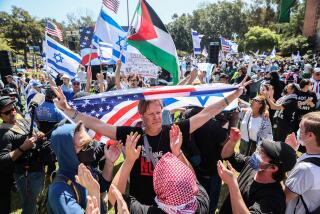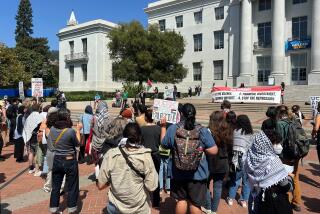25 Years Later--a New Battle at Berkeley : Activism: Plans to erect a memorial to the Free Speech Movement at UC, the first great student uprising in the 1960s, stirs debate.
- Share via
BERKELEY — Twenty-five years ago, UC Berkeley was recovering from a divisive three-month battle over the right to engage in political activity on campus--the famed Free Speech Movement.
Today, battle lines are drawn again, this time over whether the movement--the first great student uprising of the 1960s--deserves a memorial.
“The Free Speech Movement represented a rebirth of student activism in this nation and remains an inspiration to students around the world,” said Peter Selz, a retired UC Berkeley art professor and one of the main backers of a memorial.
Selz added: “Look at the students in Prague, Leipzig and Tian An Men Square; they are the direct descendants of the Free Speech Movement.”
But support for the memorial is far from unanimous. One of the memorial’s leading foes, journalism professor David Littlejohn, said that to welcome it to campus “would be to reject and insult the opinions of many who did not regard (the movement) as Berkeley’s finest hour.”
The idea of commemorating the Free Speech Movement evolved in 1988 through informal discussions among Selz, physics professor Charles Schwartz and architecture professor Galen Cranz. Some form of public art, they decided, would best honor the movement.
“We want to commemorate more than just one point of time in history here,” Selz said. “We want to commemorate the idea of free expression. We want it to serve as an inspiration for future generations of student activists.”
The three enlisted the support of many prominent faculty and student leaders, past and present, and formed the Berkeley Art Project. But rather than commission an artist, they decided to have a contest, allowing entries to be displayed and critiqued by the university community.
The contest attracted 275 entries, which on Feb 6. were narrowed to five finalists by a panel formed by the art project. The panel is scheduled to announce its top choice later this month.
Memorial backers so far have raised $30,000 from private sources. Their goal is to raise $120,000 to pay for constructing the memorial and paying the artist, yet to be selected.
Ultimately, however, several campus committees and outgoing Chancellor Ira Michael Heyman must approve the memorial concept and its final design. That is proving no sure thing.
Heyman has expressed “personal misgivings” about the project. And to many members of the campus community, the Free Speech Movement is a bad memory and an embarrassment to the school.
Littlejohn, who has taught at the university since 1963, said that by commemorating the movement, “The university would be coming down on a specific side of (what was) a passionate controversy. . . . There is no consensus on this.”
Selz conceded that the movement divided the campus. But he added: “Important events are divisive. Look at the two most divisive in American history--the Civil War and the Vietnam War. In both cases, a work of art--the Lincoln Memorial and the Vietnam Memorial--helped heal that division.”
So far, the dispute has been limited mainly to the faculty and the opinion pages of the campus newspaper. Few students have taken an interest in the issue.
“We’re in favor of the project, but it’s mainly a faculty issue,” said Cecilia Wang, a student government representative who sponsored a resolution backing the memorial. “We don’t have the time or energy to get involved in this. Besides, this is something from the past and we’re more concerned with issues that affect the future,” such as ethnic diversity among the faculty.
The Free Speech Movement began on Oct. 1, 1964, when student Mario Savio and ex-student Jack Weinberg set up a table on Sproul Plaza to recruit students into a civil rights group. The two, supported by a coalition of student groups ranging from socialists to Republicans, were intentionally challenging a 1959 UC Berkeley ban on advocating or collecting funds for off-campus causes.
Weinberg was quickly arrested by university police and placed in a patrol car. But hundreds of students surrounded the vehicle, blocking its passage and preventing police from taking him away.
While Weinberg remained handcuffed in the back seat of the vehicle, Savio and other student leaders used the patrol car as a podium for anti-administration speeches, receiving national television coverage. The standoff ended 32 hours later.
The following months were marked by protests, strikes and arrests, including one incident in which 773 students were dragged from an administration building. After a semester of rebellion, the administration gave in to the movement’s main demands, allowing students to engage in activities promoting off-campus political causes on university property.
The movement’s tactics, which included sit-ins, teach-ins, satiric songs, skits and other acts of civil disobedience, became the model used by protesters against the Vietnam War, apartheid and other causes ever since.
Like the movement they seek to honor, the memorial contest’s 275 entries ranged from the irreverent and bizarre to the abstract. They included a full-size ceramic police car, a giant screw, three monkeys in a cage, a toppled Roman-style column with a broken bust of Cicero at its feet, and four pedestals topped with busts of Abbie Hoffman sticking out his tongue.
The five semifinalists are as diverse as the group from which they were chosen.
One proposal would create a column of air 6 inches in diameter marked by a round marble “frame.” The air and the ground underneath it would be declared “not a part of any nation and not subject to any entity’s jurisdiction.”
Two other semifinalists would have practical uses. One calls for a yellow block labeled “soapbox” to be placed at the foot of the steps leading up to Sproul Hall, which fronts the plaza. Another would mount a giant electronic billboard over the student union building facing the plaza. Students and others would be able to type their ideas onto a computer terminal that would then flash the messages to thousands of passers-by.
The other two finalists propose that messages celebrating free speech be inlaid into the pavement of Sproul Plaza. One would consist of letters made of variegated red brick set directly into the pavement, while the other would have letters set into large, metal-filled cracks that would emanate from the plaza’s central fountain.
Regardless of the final pick’s artistic merit, Heyman may reject it. In a recent letter to the faculty, he wrote, “For many, perhaps most, 1964 was a time of universally shared agony.”
Heyman’s attitude surprised many because in the immediate aftermath of the Free Speech Movement he headed a faculty committee that produced a report sympathetic to the students’ goals.
But Heyman has said he now regrets much of what followed the rebellion. In his view, it opened an era of radical dominance at Berkeley that has squelched other political opinions.
Savio, now a physics teacher in Modesto, and other leaders of the Free Speech Movement--Michael Rossman, an author and teacher living in Berkeley; Jackie Goldberg, now president of the Los Angeles school board, and her brother, Art Goldberg, a Los Angeles attorney--strongly support the memorial and have contributed to it. But they are unlikely to lead any protests over it.
“I’ll send a check, but the younger generation is going to have to lead the march this time,” said Art Goldberg.
More to Read
Sign up for Essential California
The most important California stories and recommendations in your inbox every morning.
You may occasionally receive promotional content from the Los Angeles Times.













